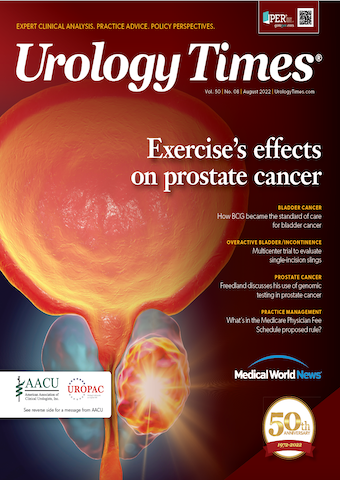Publication
Article
Urology Times Journal
What’s been the biggest change in treatments for UTIs and/or incontinence over the past decade?
Author(s):
"With urge incontinence, the biggest advantage over the past few years is the emergence, and the proven efficacy, of the β-3 agonists, which are much better medications than the anticholinergic," says 1 urologist.
Peter Jones, MD

“The urologist I trained with was an incontinence expert and was a big proponent of the bladder-neck, autologous fascial pubovaginal sling. Then came the tension-free vaginal tape, still multi-incision, and the trans-obturator urethral sling—another multiple-incision procedure.
Now, we’re down to single-incision, small slings placed with just 1 small incision in the vagina. A recent review showed the efficacy of this mini single-incision sling was equal to the much more involved urethral slings.
We’ve seen real improvement there. For the patient, it’s a much shorter operation because they’re going behind the pubic bone fascia. Risk of injury the bladder significantly decreases. It’s safer, it’s faster, and, if it’s showing equal efficacy, it’s a great advancement for patients.
We also know now that with bacterial infections for UTIs, there’s absolutely a need for genetic evaluation—both on the bacteria, because not only do we find more information about the bacteria, but also about the person’s individual susceptibility and their ability to fight off infections. We can determine, too, if there is a familial susceptibility to specific UTIs.
With urge incontinence, the biggest advantage over the past few years is the emergence, and the proven efficacy, of the β-3 agonists, which are much better medications than the anticholinergics.
The β-3 agonists present no risk of mental status changes associated with anticholinergics, and a lot of people I treat with those medications are quite happy with them.”
Peter Jones, MD
Pocatello, Idaho
Marshall Stein, MD

“With regards to incontinence from my practice standpoint, I think I’ve seen a change in the different medication profiles we can choose since I started practice. They came out with Myrbetriq and now there’s Gemtesa [vibegron]. They are more expensive medications and sometimes it’s harder, but we are generally getting them covered by insurance.
Other incontinence treatments could be coming soon. Those are MRI-compatible neurostimulators.
As far as the overall treatment, there’s nothing really different per se yet; we abide by the same concepts for treating incontinence. The overall system is stable in my practice. But the medications have been improved and cause less side effects.
For UTIs, from my standpoint, the approach has become a more detailed look at the actual infection in regards to those cases that are more difficult to treat, with neurogenic testing and the more elaborate tests they have now. Testing comes into the forefront, especially for UTIs that aren’t responding to antibiotics. We get better details on the actual microbe with regard to what they’re susceptible to so we can provide a little better treatment.
Genetic testing to determine familial connections is also being talked about, although I’m not using it a lot in my practice yet, but those evaluations can come into play with difficult or recurrent cases.”
Marshall Stein, MD
Houston, Texas

Newsletter
Stay current with the latest urology news and practice-changing insights — sign up now for the essential updates every urologist needs.



























